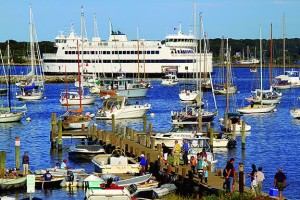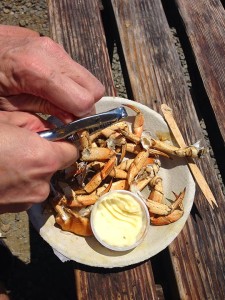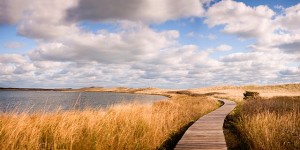A few days in Martha’s Vineyard
Martha’s Vineyard is where presidents and captains of industry have traditionally spent their summers. Barack Obama and family were recently filmed on a brief holiday pedalling their way down paths overhung with lush tree canopies. The movie ‘Jaws’ was filmed there, although the ‘Welcome to Amity’ signs and other movie-related paraphernalia have now all but disappeared. For the most part, it’s refined, leafy and almost manicured in parts, contrasting with some of the wilder, deserted-looking coastline. The resident population of around 16,000 (spread out over an island bigger than Manhattan) rises tenfold over the peak summer months – July and August.
After heading to Boston from New York City, we’d vacillated about where to go next, tossing up such variables as Maine, or driving to Montreal via Vermont. Meeting our delightful Argentinian waiter Henry at Betony, he had no hesitation in recommending Martha’s Vineyard as a spot that checked all the boxes for this part of the trip – finding somewhere new, being able to relax and, of course, getting good food.
There are things any visitor to Martha’s Vineyard should know – one in particular; there are no wineries on the island. Apparently a vineyard was tended lovingly for a few decades by a hardy resident but his children declined to keep it going. Tourism operators smile patiently when the requests for winery tours come in. We stayed in the delightful Thorncroft Inn (some of my pictures below) and pumped long-time local resident and owner Karl Buder for information. Karl and his wife Lynn (also local real-estate agents) have run the Inn since 1981. Over one of his extraordinary breakfasts, Karl told us the name was said to have been coined me when British explorer, Bartholomew Gosnold (the first person to reach the island who actually left an account about it) mistook the beach plums for grapevines. It’s thought Martha was the explorer’s mother.
To get to Martha’s Vineyard, just seven miles off the Massachusetts coast, you have two options – ferry or aircraft. There is no bridge to the island. The ferry takes all manner of cars, trucks and buses as well as foot passengers. We were driving down from Boston (roughly an hour and a half to the north), so the closest for us was to take the Steamship Authority ferry from a town called Woods Hole – there are a number of other launch points if you’re coming from New York, New Jersey or Rhode Island. You can opt to take a car from the mainland (your own or a rental) or hire transport once you’re on the island. While public transport on Martha’s Vineyard has got much better in recent years, according to Karl, sheer convenience would seem to make having a car the best way of getting value out of your visit; the six major towns on the island are widely spaced.
If you’re travelling with the Steamship Authority and bringing a car to the island, you need to make an advance booking online. The available ferries fill up quickly, especially in peak times. You need to specify the make and model of your car (so the authority can calculate how many vehicles will fit on any one boat) and advise a registration number to complete the purchase. That can be problematic if you’re hiring a car – while you’ve booked a specific make and model, you don’t know the registration until you pick it up. Just type the word RENTAL (in caps) in the space where that’s required.
It’s also handy to book your return journey in advance if you can, which you can amend later to suit your needs. Even when you’re booked on a particular ferry, you can always take a chance and ask to be put on standby for a different sailing (from either Oak Bluffs or Vineyard Haven). From Woods Hole, the ferry docks at either Oak Bluffs (a reasonably large, thriving town) or the much smaller and quieter hamlet of Vineyard Haven. It helps to have driving directions on hand from both docks. We landed at Oak Bluffs (the landing site varies on time of day/size of ferry) and it was a short, relatively easy drive to Vineyard Haven and our lovely B&B.
Martha’s Vineyard has six main towns and they’re a reasonable distance apart. Karl commented that each had its own personality and presumably all are very law-abiding. There are 10 police forces on the island – one for each of the towns, the sheriff’s office, the Massachusetts state police, the environmental police and the native American police. Perhaps that’s another reason for the tranquility you’ll find on the island, particularly if you’re there in non-peak periods.
The architecture is dominated by the use of cedar shingle cladding in typical Cape Cod-style homes (as pictured below). Karl told us some home owners opt to paint them, but when they’re left in their natural state, they darken with age. Twenty or so years down the track, at the end of their lifespan, they’re simply removed and replaced.
There are lots of activities on Martha’s Vineyard, depending on your preferences. There are beaches, walks (hikes), cycle paths; you can sail, fish, shop for local art and craft (the island is noted as a community for artists and writers. Karl told us the actor Richard Dreyfus summered there for a great many years after starring in Jaws.) Or, you can do as we did – drive leisurely around the island, exploring the different towns, going for the occasional walk and, of course, sampling the food.
So here’s a list of some of our favourite experiences.
Seafood is the way to go on Martha’s Vineyard. Everywhere you look, there are lobster rolls, clam chowder, oysters freshly shucked to order. It’s also noted, believe it or not, for a donut shop, but more on that later.
Menemsha, Edgartown and Oak Bluffs were our three favourite destinations to eat out. Having said that, there are some tourist traps.
Doing an online search of the best places to eat in Martha’s Vineyard, there’s no surprise that Larsen’s fish market in Menemsha features prominently. Sitting in the sun out back of the fish market, on a rustic timber bench overlooking the water is special. Munching a divine hot buttered lobster roll takes it a step further. A woman next to us told us she was running late to get to the airport. Would we like to have her crab claws?
Why yes, thank you very much. These took rather longer to consume than the lobster roll, which my husband seemed to devour in a couple of bites.
It’s easy to park at Menemsha (in the town of Chilmark) in the off-season (we were there in early June). When the population swells, that might prove a little trickier, but certainly worth persevering with. There’s also an outlet at Menemsha for the Beetlebung coffee shop (see the blog Coffee in the US for more) but it only opens during the high season.
The Menemsha Hills Reservation is also a lovely place to walk. You can ‘scale’ the highest point on the island (around 100 metres). The tiny sign leading down to where you can park is difficult to spot. Despite very good written directions, we needed to flag down a local and ask. This is also the area for largely unimpeded sea views (the towns of Chilmark and Aquinnah) and there are a fair few lighthouses.
For some unpretentious, basic food in Oak Bluffs, Linda Jean’s in Circuit Avenue is a good stop. We needed a break from full-on restaurant fare and this diner was a good respite – although be warned that the servings are enormous. When I commented to the waitress that I was looking for a small snack, her reply summed it up: ‘We don’t do small’.
Walking along the waterfront at Oak Bluffs gives a great view of the local architecture, with some quirky twists and outrageous paint jobs.
As mentioned previously, Vineyard Haven is quite a small community. We enjoyed some hearty food, executed reasonably well at The Black Dog Tavern. Edgartown is probably the biggest town on the island and has a number of fine-dining establishments that were heartily recommended. We opted, however for the Atlantic Fish and Chop House and ate extremely well, sharing just a few extremely large dishes. There’s much more to choose from in Edgartown than the other towns but be aware again that parking in the high season may be hard to come by. In that case, parking a little way out of town and walking in could be quite pleasant.
We’d also heard good reports about Espresso Love here as an option for coffee; it was a pleasant enough place to sit but had a couple of disadvantages in our opinion – it was very close to where tour buses pull up and we couldn’t seem to communicate all that well with the barista to try to get a more European-styled coffee. Back to Beetlebung we went!
There are lots of colonial-era buildings in Edgartown and a walk through the streets is a nice thing to do.
All told, we were on Martha’s Vineyard for three nights and found it to be relaxing and a nice foil from the very big, busy cities elsewhere on our US tour. Our B&B was very comfortable and our hosts as involved with our plans as we wanted them to be, so perfect for both the independent traveller and someone who likes a little more guidance.
Driving around the island is very straightforward (once you work out some of the one-way roads that go through many of the towns) and we were able to enjoy a leisurely pace. The weather (except for the final day when it turned bleak) was also quite beautiful in early June – the best of the weather plus ease of navigation without the crowds!
Martha’s Vineyard is not a particularly inexpensive place to visit but, for the quality of what you get, there’s a lot to like about it.
With thanks to the Martha’s Vineyard Chamber of Commerce for supplying some of the images used in this post.











Comments